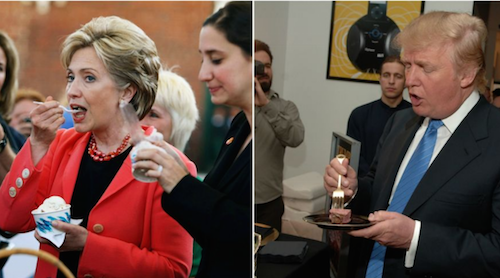Layering Political History and Current Events
A MiddleWeb Blog

The strategies I found useful last spring for political discussions are still helpful, but this fall’s political climate feels icy serious, with not much room for play.
Yet, each year in eighth grade U.S. history, I like to begin by examining how we get and interpret our news – and I’m not about to give that up.
Our two-week current events unit piques students’ curiosity about the world around them, exposes them to current vocabulary terms, and gives them ownership over important news sites.
So I decided to approach this year’s exploration of the news a little differently. Rather than explore a different current event each day, as we had done in previous years, I decided to apply to this fall’s presidential campaign one of my favorite history teaching strategies: what I call layering.
How layering works in the classroom
Layering comes when we study a series of sources – primary and secondary, current and historical, written texts and audio clips and videos – and anticipate that, by the end of our efforts, the sum will be much greater than the parts.
I love this layering strategy for many reasons:
It builds in review automatically, as we’re always looking to the previous days’ sources to supply illumination on today’s source.
- It lends itself to rich culminating projects or reflections, such as concept maps.
- It creates a focal point for thematic teaching.
- It asks us to apply a sense of wonder and imagination to time periods that may seem like our own but in fact held very different constraints in terms of technology, government and relationships.
So, what did we layer to jump into the campaign, directly and indirectly?
Day 1: What the Candidates Eat
On Day 1, we looked at a very light piece (like this one) about what each presidential candidate likes to eat. After reading bits of it together on-screen, students wrote individually for five minutes about whether we should care about what presidential candidates eat.

Their responses varied wildly from section to section. Some students believed that we should focus on more important issues, while others thought that how candidates take care of themselves with food reflects how they take care of the rest of their lives.
We made a pro/con chart on whether the media should focus on such light topics, thus moving the discussion more into media literacy than political mudslinging.
Day 2: Gloria Steinem as ‘Celestial Bartender’
On Day 2, we moved back into history about 40 years. One of the most striking aspects of Gloria Steinem’s recent book My Life on the Road comes in her description of “campaigning” as a community organizer in the 1960s and 70s.

Students read a couple of paragraphs from her description and then picked a quotation or two they liked to write out and explain why they liked it. Many liked the one above about listening. Others chose a quotation about finding answers: “I’ve noticed that great political leaders are energized by conflict. I’m energized by listening to people’s stories and trying to figure out shared solutions. That’s the work of an organizer” (136).
Day 3: The Endless Road to the Vote for Women
Day 3 brought us back nearly a century, to a secondary source description of the “campaigning” of Susan B. Anthony and Elizabeth Cady Stanton for women’s suffrage in the 1870s and 1880s.
By this point, the 1848 Seneca Falls convention was a distant memory, and the passage of the Nineteenth Amendment in 1920 not a glint in suffragists’ eyes.
Ever since I had read historian Christine Stansell’s description of Stanton’s complaints about traveling across the country in The Feminist Promise: 1792 to the Present, I hadn’t been able to get the words out of my head. According to Stansell, Stanton despaired of “awful roads, dreadful roads, long, terrifying and horrible roads” and lamented in 1889 that she was “sick of all organizations” (111).
Once we had read a couple of paragraphs about Stanton’s weariness, students took about ten minutes to write in response to this question:Do you think you would have had the endurance and interest to keep traveling around the country in the 1880s, or the 1970s, or perhaps today, for a cause you believed in? Why or why not?
A handful of students thought a cause would inspire them enough to stay on the road, but most believed they would want to sleep in their own beds after a couple of weeks.
Day 4: John Oliver on “Clickbait”
We waited several days for the last source – after students had interviewed parents or other adults about how they watch the news, discussed all 30 of this year’s current events vocabulary terms, and spent a period looking up interesting headlines at the Washington Post, Wall Street Journal, Los Angeles Times and New York Times.
And then Day 4 of layering brought, finally, some humor in the form of satire: John Oliver’s frighteningly accurate skewering of the news industry’s focus on “clickbait” articles rather than investigative journalism. (If you show this clip, I would suggest starting at approximately 14:45. Also, it includes several bleeped-out curse words.)
As students watched a fake movie trailer about a media conglomerate that prioritizes cuteness over meaning, they laughed and, I think, got the point – that their current events articles should focus more on the kinds of serious issues for which reformers over the decades have campaigned and perhaps less on what Hillary Clinton ordered at a Chipotle in Toledo, Ohio, this summer.
Layer by Layer
It was easy to pull out the Steinem and Stanton sources because I had taken an online course on women’s history in the spring.
However, it’s also easy to layer just about any sources that are thematically related. Often I start with a primary source I use in class already and then link it to a primary source from a different time period and a current newspaper piece.
With such an approach, students not only see thematic connections, but they also realize – as we will discuss all year – that the current events of today become the history of tomorrow.

 It builds in review automatically, as we’re always looking to the previous days’ sources to supply illumination on today’s source.
It builds in review automatically, as we’re always looking to the previous days’ sources to supply illumination on today’s source.![s-c-grabill_-_the_deadwood_coach-2 | MiddleWeb John C. H. Grabill [Public domain], via Wikimedia Commons](https://www.middleweb.com/wp-content/uploads/2016/09/s-c-Grabill_-_The_Deadwood_Coach-2.jpg)






























I am an 8th grade teacher and I constantly feel like I am dragging my students along. I want them to get engaged and this layering sounds perfect. Would you be willing to share portion of the Steinem and Stanton sources that you used?
Robert, so glad you found this helpful. I will send you the excerpts by email, as I haven’t found them posted online anywhere.
This NYT Learning Network article will likely be of interest to readers of Sarah’s post:
Talking Across Divides: 10 Ways to Encourage Civil Classroom Conversation On Difficult Issues